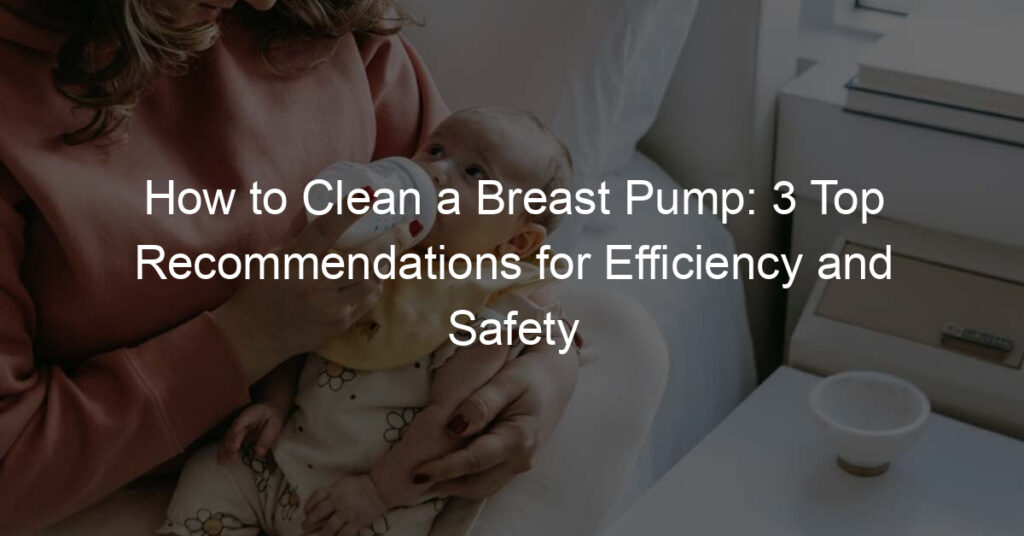Cleaning a breast pump is an essential task for maintaining the health and safety of both the mother and the baby. It not only ensures that the pump stays in good working condition but also prevents the growth of harmful bacteria that can contaminate the expressed breast milk.
With proper care and knowing how to clean a breast pump, it can be a valuable tool for busy moms, helping them continue to provide their babies with the numerous benefits of breast milk even on the go.
Understanding the importance of cleaning a breast pump is only the first step; knowing the correct techniques and recommendations is crucial for keeping the pump and its accessories germ-free.
In this article, we will discuss three top recommendations for cleaning a breast pump, along with a step-by-step guide on how to do it effectively and efficiently.
We will also share some useful tips and tricks to make the process easier, as well as common mistakes to avoid.
Key Takeaways
- Proper cleaning is essential for maintaining breast pump hygiene and preventing bacterial growth
- Follow recommended cleaning techniques for the most effective and efficient results
- Utilize tips and tricks to make the process easier and avoid common cleaning mistakes
How to Clean a Breast Pump

Cleaning a breast pump is an essential task for maintaining proper hygiene and ensuring the safety of the breast milk being provided to the baby.
Regular cleaning helps to prevent the build-up of bacteria, fungus, and mold on the breast pump parts.
These contaminants could lead to potential health issues for the baby if present in the breast milk.
There are several reasons why cleaning a breast pump is important. Firstly, breast milk can contain harmful bacteria and viruses if not handled properly.
Cleaning the pump components thoroughly, the risk of spreading such pathogens is minimized, protecting the baby from potential infections and illnesses.
In addition, breast pumps have numerous small parts that can trap milk residue – a perfect breeding ground for bacteria. Proper cleaning of these intricate components is crucial to avoid any contamination.
Unclean breast pumps pose a risk to the babies, affecting their overall health, growth, and development.
Lastly, maintaining a clean breast pump helps to prolong its lifespan and ensures its efficiency.
Consistent and proper cleaning will keep the pump working effectively and maximize milk production, providing optimal nutrition for the baby.
The importance of cleaning a breast pump cannot be overstated. Adopting a regular cleaning routine will ensure the health and safety of your baby while maximizing the efficiency and longevity of the breast pump.
When to Clean Your Breast Pump
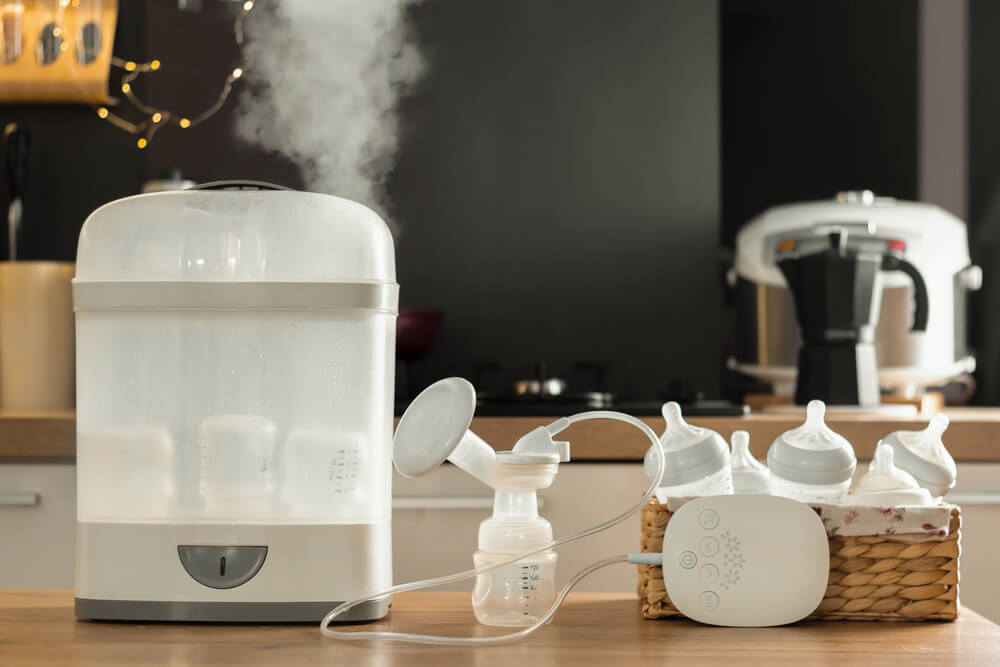
Cleaning your breast pump is necessary to maintain hygiene and ensure the safety of your breast milk for your baby.
It’s important to clean your breast pump at specific times to maximize its effectiveness and longevity.
Firstly, you should clean your breast pump immediately after each use. This helps prevent the build-up of milk residues which can harbor harmful bacteria, as well as mold growth.
Washing your hands with soap and water for 20 seconds before handling the pump is also essential to keep everything clean.
In addition, it is a good practice to clean the breast pump before your first use and after a prolonged period of storage. This ensures that any dust or contaminants that may have settled during storage are removed before using the pump.
Make sure to inspect the pump kit and tubing for mold or signs of wear and replace immediately if any issues are found.
If you’re using a shared pump, like in a workplace or hospital setting, it’s crucial to clean the pump dials, power switch, and surrounding countertop with a disinfectant wipe before and after use to minimize cross-contamination.
By cleaning your breast pump at these specific times, you can be confident that your breast milk remains safe for your baby and that your pump stays in optimal condition.
3 Top Recommendations for Cleaning a Breast Pump
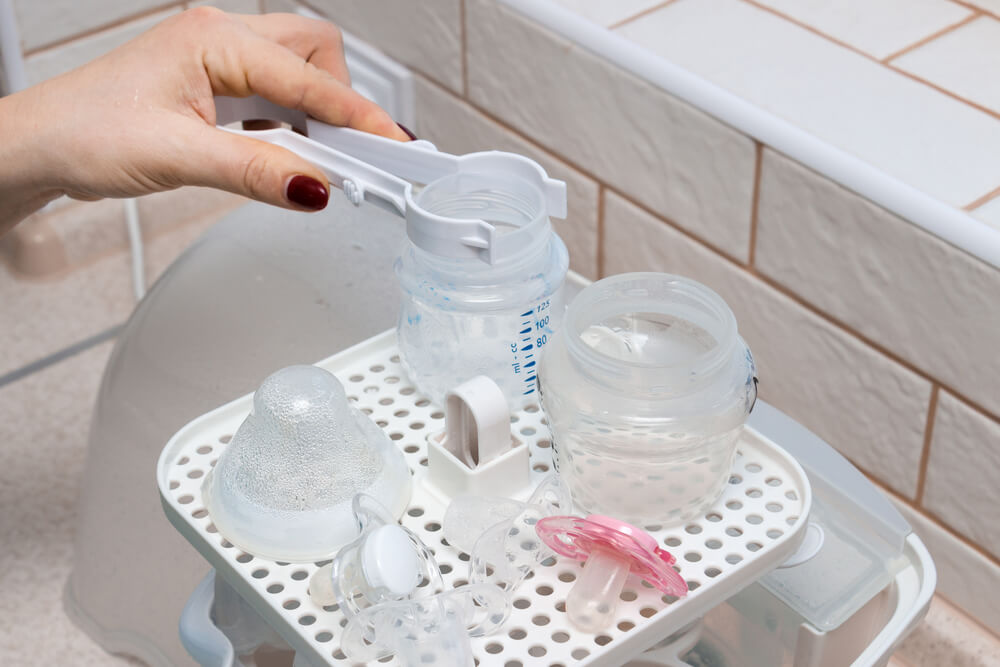
Recommendation 1: Use a Breast Pump Cleaning Kit
Using a breast pump cleaning kit is a reliable and hassle-free way to clean your breast pump. These kits are specifically designed to help you clean the pump parts effectively and efficiently.
They usually include brushes and sponges tailored to fit various pump parts, as well as cleaning solutions that are gentle on pump components while being effective against bacteria and germs.
By using a cleaning kit, you can ensure that your breast pump is well-maintained and safe for use.
Recommendation 2: Keeping Breast Pump Parts Safe
Proper storage and handling of breast pump parts can significantly impact their cleanliness and lifespan.
Be sure to:
- Wash your hands: Before handling pump parts, always wash your hands with soap and water for at least 20 seconds.
- Inspect pump parts: Before assembling your breast pump, check for mold or any sign of damage. If the tubing is moldy, discard and replace it immediately.
- Clean after each use: Clean every part of the breast pump that comes in contact with your breast or the milk, including breast shields, bottles, bottle lids, valves, membranes, and connectors, after each use to prevent the growth of bacteria and dried milk residue. You can find details on cleaning various parts in the manufacturer’s manual.
- Air-dry pump parts: After cleaning, allow pump parts to air-dry completely on a clean, dry surface to prevent bacterial growth.
- Store pump parts properly: When not in use, store pump parts in a clean, dry area, such as a cupboard, to protect them from dust and contaminants.
Recommendation 3: Regular Sterilization of Pump Parts
Sterilizing your breast pump parts regularly can effectively kill bacteria and keep your pump clean and safe for use. In general, it is a good practice to sterilize breast pump parts at least once every 24 hours or according to the manufacturer’s guidelines.
Some common sterilization methods include:
- Boiling: Boil pump parts in a large pot of water for 5-10 minutes, ensuring they are submerged and not touching the pot’s sides or bottom. Then remove with clean tongs and allow them to air-dry on a clean, dry surface.
- Steam sterilization: Use a microwave steam sterilizer or electric steam sterilizer following the manufacturer’s instructions to sterilize your pump parts effectively.
- Sterilizing solution: Soak the pump parts in a sterilizing solution, such as a mild bleach solution, following the manufacturer’s guidelines for the appropriate soaking time and dilution ratios. Afterward, rinse the parts and let them air dry.
Remember to always follow the specific sterilization recommendations provided by your breast pump’s manufacturer to ensure proper care and maintenance.
Step-by-Step Guide to Clean a Breast Pump
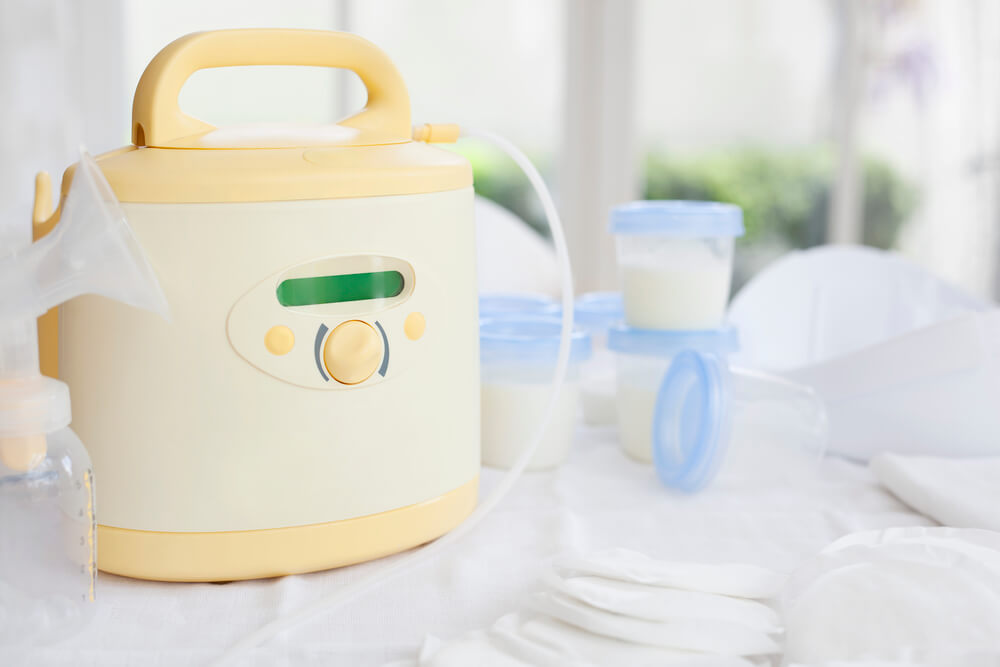
Cleaning a breast pump properly is essential to ensure the safety and health of the baby.
In this guide, we will provide a step-by-step process to clean your breast pump effectively.
First, it is crucial to wash your hands with soap and water for 20 seconds before handling any breast pump parts. This will help prevent the spread of germs and bacteria.
Next, consult the breast pump’s instruction manual for guidance on which parts should be cleaned and how to disassemble them.
Each breast pump model may have different instructions, so it is crucial to follow the manufacturer’s recommendations to ensure proper cleaning.
Once the parts have been disassembled, rinse each piece that comes into contact with breast milk under cool running water. This will help remove milk residue before washing. After rinsing, wash the parts with warm soapy water, using a soft brush if necessary.
Some manufacturers recommend using a dedicated brush to scrub breast pump kit parts, but be sure to follow the specific instructions for your pump.
It is essential to clean the pumping area as well. Use disinfectant wipes on the countertop or surface where the pump and bottles are placed during the session.
This will help eliminate any germs that may be present.
After washing all parts, rinse them thoroughly under running water, making sure all soap residue is removed. Then, place the clean parts on a clean, dry towel or a drying rack, allowing them to air-dry completely.
Avoid using cloth or paper towels to dry the pump parts, as these can leave lint behind and become a breeding ground for bacteria.
For a shared pump, ensure that you also clean the pump dials, power switch, and countertop with a disinfectant wipe to minimize the risk of contamination.
Finally, once all the parts are dry, reassemble the pump kit carefully, ensuring all components are properly connected.
Inspect the tubing for any mold or dirt, and if needed, replace the tubing to maintain the cleanliness and efficiency of the breast pump.
By following these steps, you can be confident that your breast pump is clean and safe for use in providing nourishment for your baby.
Tips and Tricks for Cleaning
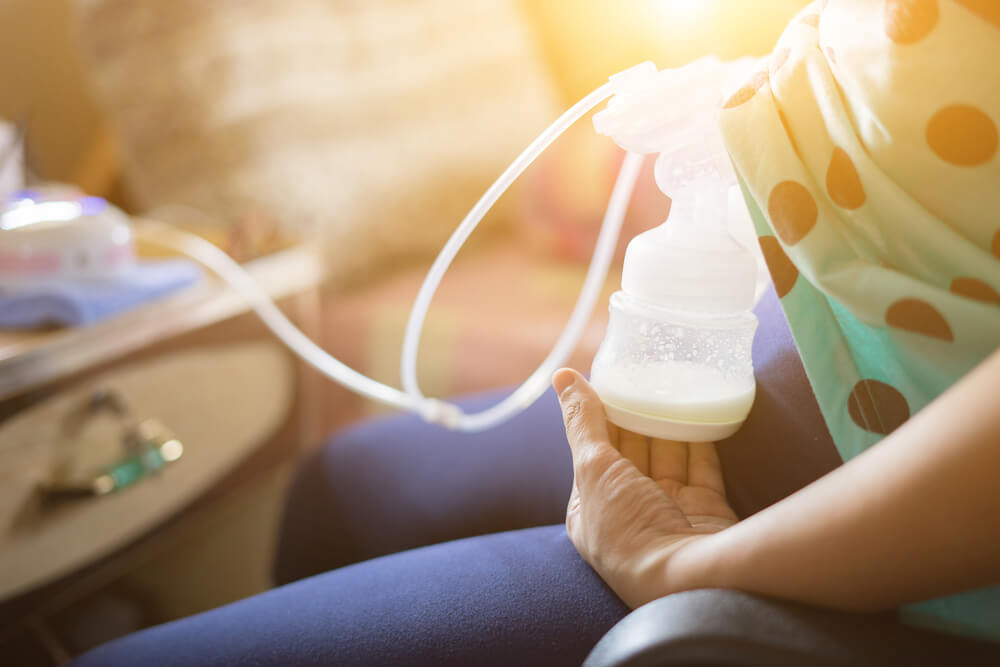
Cleaning your breast pump can seem overwhelming, but with a few simple tips and tricks, you’ll have a clean and germ-free pump in no time. First and foremost, always wash your hands with soap and water for 20 seconds before handling your breast pump or its parts.
This ensures that you’re not transferring any unwanted germs to the pump.
Instead of washing pump parts directly in the sink, use a wash basin filled with hot water and soap – specifically for cleaning infant feeding equipment.
This helps to avoid contamination from germs in sinks or drains that could potentially transfer to your breast pump.
Here are three top recommendations for cleaning your breast pump:
- Follow the manufacturer’s instructions: Always consult your breast pump’s instruction manual for specific cleaning guidelines, as every model might have different recommendations and instructions for disassembling and cleaning.
- Clean each part that comes in contact with breast milk: After using your breast pump, it is important to rinse each piece that comes into contact with breast milk to remove any residue. This includes the pump flanges, valves, and bottles. After rinsing, wash these parts with hot, soapy water before allowing them to air dry on a clean towel or drying rack.
- Disinfect your breast pump once a day: In addition to regular cleaning after each use, be sure to disinfect your breast pump at least once a day. You can do this by using steam bags specifically designed for this purpose or by boiling the parts in water for a few minutes. If you are using a shared pump, remember to clean the pump dials, the power switch, and the countertop with disinfectant wipes.
Following these tips and recommendations, you’ll be sure to have a clean and well-maintained breast pump that provides you and your baby with safety and peace of mind.
Common Mistakes to Avoid
When cleaning a breast pump, it’s essential to be aware of some common mistakes in order to keep your pump functioning properly and ensure a safe environment for your baby.
Avoiding these pitfalls can confidently maintain the cleanliness and hygiene of your breast pump.
One common mistake is failing to wash hands thoroughly before handling the breast pump. It’s essential to wash your hands with soap and water for at least 20 seconds to reduce the risk of contaminating your pump or breast milk with harmful bacteria.
The CDC emphasizes the importance of handwashing in maintaining proper hygiene for your pumping equipment.
Another error is using cloth towels to dry pump parts after washing. Cloth towels can harbor germs and bacteria, which may contaminate your breast milk and pose a risk to your baby.
Instead, the FDA recommends air-drying the parts on a clean, unused paper towel or allowing them to air-dry in a clean environment, away from direct sunlight.
Not paying attention to the manufacturer’s instructions is another common mistake. CDC recommends following the pump manufacturer’s guidance, including whether to use a brush to scrub the pump parts.
Scrubbing with a brush may damage some breast pump components, compromising their functionality or safety.
Failing to regularly inspect the pump kit or tubing for signs of mold or dirt is also a mistake to avoid.
According to HealthyChildren.org, it’s crucial to check the pump kit and tubing for any signs of dirt or mold before each use, as moldy parts need to be discarded and replaced immediately.
By avoiding these common mistakes, you can ensure a safer and cleaner environment for your baby while using a breast pump and maintain the overall effectiveness of your pumping equipment.
Conclusion
Cleaning a breast pump is crucial to ensure the safety and health of both mother and baby. By following these top three recommendations, one can maintain the cleanliness of their breast pump and prevent the growth of bacteria.
Firstly, it is essential to wash your hands well with soap and water for at least 20 seconds before handling the breast pump or its accessories.
This is the first line of defense against contamination and helps to reduce the risk of transferring germs or bacteria to the pump or breast milk.
Secondly, make sure to clean all the parts of the breast pump that come into contact with the breast or milk.
According to Medela, this includes breast shields, breast milk bottles, bottle lids, valves, membranes, and connectors. Regular and thorough cleaning can help avoid dried breast milk residue and prevent the growth of bacteria.
Lastly, for those using shared pumps, make sure to clean the pump dials, power switch, and countertop with disinfectant wipes. This practice ensures that no surface contamination is transferred from one user to another.
Implementing these recommendations, users can maintain a clean breast pump and contribute to the overall health and well-being of their infant.
Frequently Asked Questions
What is the best way to sterilize breast pump parts?
To sterilize breast pump parts, start by separating all the removable components. Boil them in a large pot of water for at least five minutes, ensuring they are fully submerged. Carefully remove the pieces and place them on a clean, dry surface to air dry.
Keep in mind that not all parts can withstand high temperatures, so consult your breast pump’s manufacturer’s instructions to verify compatibility.
Which soap should be used for cleaning breast pump components?
Choose a mild, fragrance-free, and residue-free dish soap to clean your breast pump components. Avoid antibacterial soaps, as they might leave a residue on your pump parts. Always rinse thoroughly to ensure no soap residue remains on your equipment.
How can I properly clean breast pump tubing?
To clean breast pump tubing, first check the manufacturer’s instructions for proper care. Most tubing can be washed using mild soap and warm water, ensuring that you reach the entire length of the tube. Shake it out and hang it vertically to air dry completely.
If the tubing becomes moldy or discolored, discard and replace it immediately.
What are the CDC guidelines for breast pump cleaning?
The CDC establishes recommendations for breast pump cleaning, such as washing your hands well with soap and water before handling pump parts, following the manufacturer’s guidelines, cleaning the pump dials and exterior with disinfectant wipes, and allowing parts to air dry completely on a clean surface.
Do you need to clean breast pump parts before their first use?
Yes, you should clean all breast pump parts before their first use.
Follow the manufacturer’s instructions for cleaning and sterilizing the components, as this will help remove any potential contaminants present during manufacturing and packaging.
What are some tips for storing breast pump parts between uses?
To store breast pump parts between uses, allow them to air dry completely on a clean surface, then store them in a clean, protected area. Consider using a sealed container or a resealable plastic bag to shield them from contaminants.
Avoid stacking parts directly on top of each other to prevent scratching and damage.

